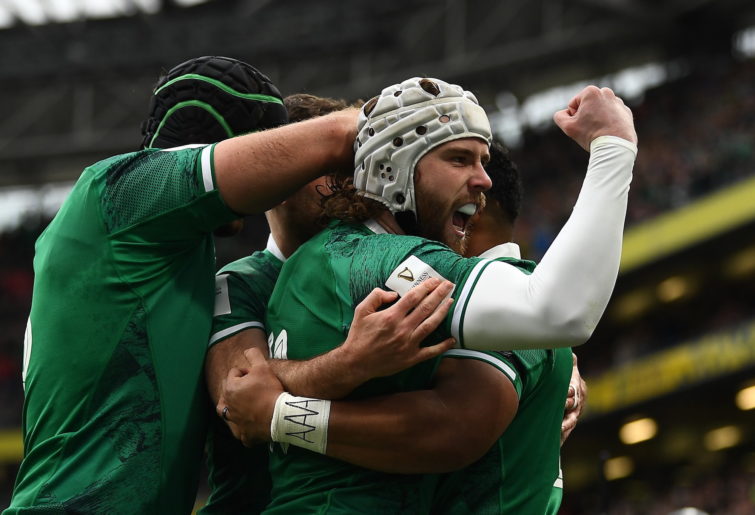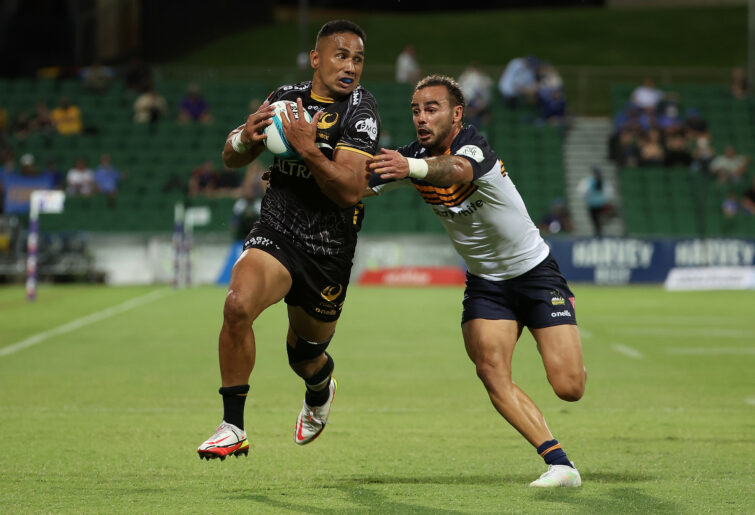The answer to this question has many variables, but in its simplicity, if it comes to money, nothing else.
The domestic players, without a Super Rugby contract, can earn up to $200,000 overseas in the US or Japan, but Europe doesn’t necessarily have an appetite for this group. But there are a few.
The players in domestic competitions are good enough for overseas but not for Super Rugby. Some have gone on to huge honours and are established in the national programs or are legends for their country.
The key example is Mack Hansen recently for Ireland.
Hansen was wanted by the Brumbies, but not from RA. He is clearly a strong player, but was blocked by Tom Banks.
Tom Banks has excelled at Super Rugby, but not nailed down the Wallabies’ fullback position. But he is being offered from media reports $1.5 million per season to play in Japan.
He is an outstanding player, as is Hansen, can RA keep both.
In short, no.

(Photo By Harry Murphy/Sportsfile via Getty Images)
The money from the global game of rugby union is huge in comparison to what RA or Super Rugby can offer.
My kids often say to me, there’s more money in league than union. I respond with, ‘only in Australia’.
If you have skills but are short of a step or two (maybe more, they’re developing), then rugby can show you the world.
When Israel Folau switched to rugby union in his second year, he offered up that rugby league gave him an opportunity to travel from Minto to Sydney, Melbourne and the ACT.
But in his second year of rugby, he had been to Japan, New Zealand and most of the UK and France.
Now the travel is one hell of a carrot, but when we are talking $300,000 per year for three years, I can understand.
Perhaps it’s time for a Cricket Australia model where the elite players are contracted for a year (probably, won’t retain to many, so two or three may suffice), which would allow the players to be contracted via a club elsewhere, similar to the IPL in cricket or other T20 leagues.
Cricket, as I understand, has 20-25 contracted players across three formats. The highest are maybe paid $1.5 million to $2 million with a national audience.
Rugby Australia is not having the same luxury of television ratings but will come 2027 and 2029.
If RA receives $38 million per year for broadcast rights and player wages equate to approximately 70 per cent, that allows $26.6 million for salaries.

(Photo by Paul Kane/Getty Images)
Now, cricket has 11 players on the field at anyone time, and rugby has 15 plus reserves.
I don’t think there is a code in Australia that is paying players at the elite level at their optimum price across one entity, with the exception of CA.
Football and cricket are the only other sports that have the same competitive markets and can offer more.
In these two codes, football is funded by the clubs and releases players for national duty (similar to European and Japanese clubs for rugby union).
I’m sure their earnings are far superior to their national bodies. In fact, if reporters tell the truth, they are.
By being the preferred candidate for the men’s Rugby World Cup in 2027 and the women’s Rugby World Cup in 2029, RA have an opportunity.
Tier 1 – national
If you have five players at $1 million plus, the total spend is $5.5 million on average (based on $1.1 million each).
Five players at $750,000 to $1 million is a total spend of $4.375 million on average.
Five players at $500,000 to $750,000 is a total spend of $3.125 based on a $750,000 average.
This is a total of $13 million.
They are retained to RA for a period of time and they have some control.
If these players can supplement their income elsewhere, why refuse it. Each club (world wide) can bid on their services.

(Photo by Buddhika Weerasinghe/Getty Images)
Tier 2 – development
This may impact the Super Rugby Pacific competition, but that would allow the $13.6 million amount for the five remaining clubs.
That would give each franchise $2.72 million plus their gate taking and sponsorship.
If RA could secure another $5 million to $10 million in revenue through gate takings and jersey sponsors and 30 per cent is delivering up-and-coming talent, that is an additional $1.5 million to $3 million in junior talent, perhaps across ten individuals.
When you look at the NRL talent pool, there are maybe ten $1 million-per-year players spread across 16 (soon to be 17) clubs.
Rugby union is thriving globally. The money is ridiculous. Many rugby league players have tried and failed. Rugby union players enjoy the product and the experience.
Rugby Australia needs to embrace the global game. Combine a Cricket Australia model with world football.
Encourage sabbaticals, but with a national interest at heart.

(Photo by Getty Images)
The difference between what happened to football in Australia years ago is that we wanted to show our abrasive essence in one-on-one contact. Football didn’t offer it.
AFL is still here and always will be, rugby league will follow our path, football is what started them all.
Let’s embrace the change and see rugby for what it is.
It is a complete game. Athletes can achieve their dreams. Keep them in Australia to play for their national team.
Play the game of rugby union.
Rugby Australia, this is what to do: keep your top players here.
Too many players leave who are not Super Rugby level and play as rockstars overseas.
Don’t dismiss the Shute Shield or domestic competitions as my commentators have advised the case in point is Mack Hansen and at least three from Darren Coleman for the Tahs.
Offer an elite second and developing class.
The average NRL player is on $250,000.
Build a platform.
The talent coming through is huge. Keeping them is the problem. Give them a pathway.
Stages one, two and three: one is developing, two is contracted for an extended period, three is contracted but pick and choose your supplementary income across four continents.
































































































